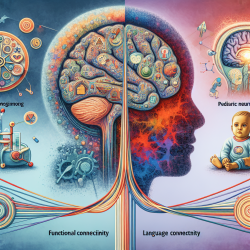Introduction
In the realm of pediatric speech-language pathology, understanding the impact of early brain injuries on language development is crucial. A recent study titled "Functional connectivity of language networks after perinatal stroke" sheds light on how perinatal strokes affect language networks in children. This blog post will delve into the findings of this study and discuss how practitioners can leverage these insights to enhance therapeutic outcomes for children affected by perinatal strokes.
Key Findings from the Study
The study examined the functional connectivity (FC) of language networks in children who experienced perinatal strokes, comparing them with typically developing controls (TDC). Using resting-state functional MRI, the researchers found significant differences in the connectivity of language networks between children with arterial ischemic stroke (AIS) and those with periventricular venous infarction (PVI), as well as TDC.
- Children with left hemisphere strokes exhibited compensatory right-lateralization of language functions.
- Arterial strokes resulted in less connectivity compared to venous strokes and controls.
- Reduced connectivity was linked to poorer language comprehension performance.
Implications for Practitioners
These findings have significant implications for therapeutic interventions and instructional strategies. Practitioners should consider the following approaches:
- Customized Language Interventions: Tailor language therapy to strengthen connectivity in affected regions, focusing on enhancing comprehension skills.
- Use of Resting-State fMRI: Incorporate resting-state fMRI in assessments to better understand individual connectivity patterns and adjust therapy accordingly.
- Early Intervention: Initiate language interventions early to capitalize on the brain's plasticity and potential for compensatory reorganization.
Encouragement for Further Research
While this study provides valuable insights, it also highlights the need for further research. Practitioners and researchers are encouraged to explore:
- The long-term effects of different types of perinatal strokes on language development.
- The potential for non-invasive brain stimulation techniques to enhance language recovery.
- Comparative studies on the efficacy of various therapeutic interventions in improving language outcomes.
Conclusion
The study on functional connectivity of language networks post-perinatal stroke offers a data-driven foundation for improving therapeutic strategies. By understanding the unique connectivity patterns in affected children, practitioners can tailor interventions to foster better language outcomes. For those interested in delving deeper into the research, the original paper can be accessed through this Functional connectivity of language networks after perinatal stroke.










